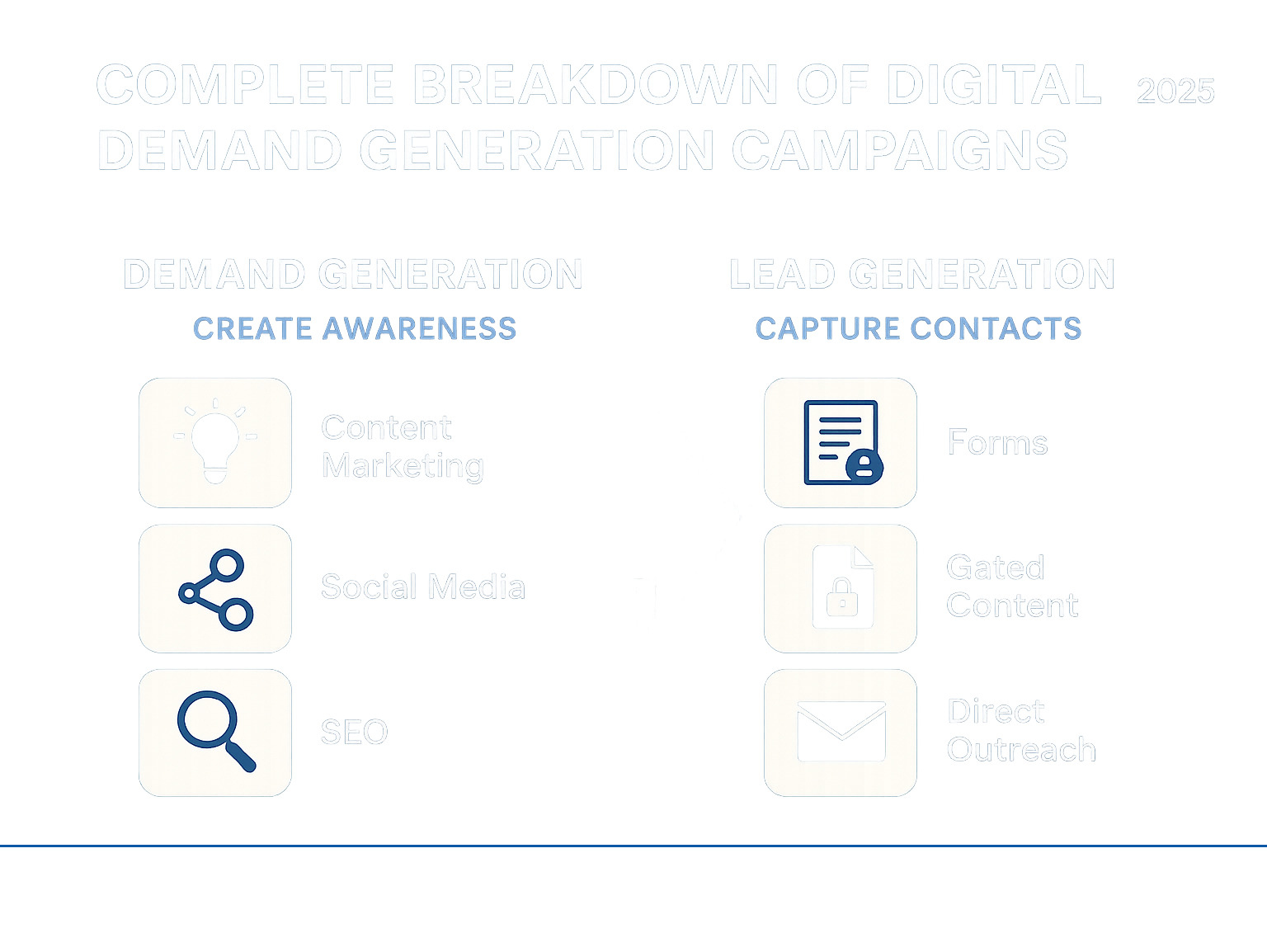Why Digital Demand Generation Campaigns Are Your Key to Sustainable Growth
If you feel like you're constantly chasing the next sale without building lasting momentum, you're not alone. Many businesses focus all their energy on asking for the sale right away. But what if there was a better way to grow? That's where digital demand generation campaigns come in. These are data-driven marketing plans designed to create genuine awareness and interest in your products or services. Instead of just capturing contact information like lead generation does, demand generation focuses on building trust and educating your audience long before they're ready to buy. It's about playing the long game to create a loyal customer base.
Key Parts of Digital Demand Generation
Understanding the core parts of demand generation helps clarify its role in your marketing:
- Purpose: The main goal is to create awareness and interest, not just to collect leads. It's about making your brand a familiar and trusted name in your industry. When a potential customer starts looking for a solution you offer, your name should be the first one that comes to mind.
- Focus: The effort is concentrated on top-of-the-funnel activities. This means reaching people who may not even know they have a problem yet, or are just starting to research solutions. The aim is to build brand recognition and establish your company as a helpful resource.
- Content: The content you create should be educational and solve problems for your audience. Think blog posts, how-to guides, videos, and infographics that provide real value without asking for anything in return. This is how you build authority and trust.
- Channels: You'll use a mix of digital channels to spread your message, including SEO, social media, paid ads, email marketing, and webinars. The key is to be present where your audience spends their time.
- Timeline: This isn't a quick fix. Demand generation is a long-term strategy focused on building relationships. The trust you build over time pays off with more loyal customers and sustainable growth.
- Measurement: Success is measured by tracking things like brand awareness (how many people know about you), involvement (likes, shares, comments), and how your efforts influence the sales pipeline down the line.
The difference between demand generation and lead generation is crucial for your marketing success. As one marketing expert puts it: "Demand generation is, in a phrase, reputation setting at a marketing level." While lead generation is the act of converting interested people into sales opportunities, demand generation builds the foundation of trust that makes those conversions happen in the first place.
Why This Matters for Your Business
So, why should you invest time and resources into this? The data is clear. Research from Conductor shows that customers are 131% more likely to buy from brands after they read their educational content. This means your demand generation efforts directly affect your bottom line. By providing value upfront, you build the credibility and relationships that drive sales. You're not just another company trying to sell something; you're a trusted partner helping them make an informed decision.
For ecommerce businesses, this is especially important. Think about how people shop now. 63% of consumers find new products or brands on Google feeds, and 91% of those consumers take action immediately. This is a huge opportunity. When someone sees your helpful blog post or video in their Google Find feed, you're not just interrupting them with an ad—you're providing a solution. A strong demand generation strategy ensures you're the one they find.
I'm Steve Pogson, founder of First Pier, a Shopify Expert Agency. I've spent more than two decades helping businesses build successful digital demand generation campaigns that create lasting growth. Throughout my experience scaling ecommerce stores and putting in place detailed marketing strategies, I've helped owners overcome the challenge of being invisible online. I've seen how a smart demand generation plan can transform a business from an unknown name into a trusted industry leader.

Digital demand generation campaigns terms simplified:
- advertising campaigns
- campaign management in digital marketing
- how to optimize digital marketing campaigns
What is Demand Generation (and How is it Different from Lead Generation)?
When business owners ask me about their marketing, one question always comes up: "What exactly is demand generation, and how is it different from lead generation?" It's a great question, and knowing the difference is key to building a marketing strategy that actually works instead of just spinning its wheels.
Think of digital demand generation campaigns as the foundation of your entire marketing house. It's a complete approach to inbound marketing that focuses on creating real interest and awareness in your brand. My goal with demand generation isn't to immediately ask for an email address. It's to build trust, show my expertise, and make sure that when someone is finally ready to buy, my brand is the first one they think of. It's the solid ground everything else is built on.
Lead generation, on the other hand, is the front door of that house. It's the specific action someone takes when they're already interested and want to learn more—like signing up for your newsletter, adding an item to their cart, or downloading a style guide. Without the foundation of demand generation, very few people will ever find or trust your front door.
Here's a simple way to think about it: If you sell artisanal chocolates, demand generation is all the work you do to make people crave high-quality chocolate. You might share articles on the health benefits of dark chocolate, post videos of your bean-to-bar process on social media, or create beautiful images that show off your unique packaging. You're building a desire for the experience of great chocolate. Lead generation is when a person who now craves that chocolate visits your website and signs up for a 10% discount on their first order. One creates the desire; the other captures the interested person.
This difference is so important because many businesses jump straight to lead generation. They push for the email signup or the immediate sale without first building trust. That's like asking a stranger for their phone number five seconds after meeting them—it's awkward and rarely works.
The Goal: Creating Demand, Not Just Capturing Leads
The main goal of digital demand generation campaigns is to build your reputation at scale. I'm not trying to get contact information right away. Instead, I'm laying the groundwork for long-term relationships by educating my audience and solving their problems, sometimes before they even realize they have one.
This educational approach is effective throughout the entire customer experience. At the Top of the Funnel (TOFU), where people are just starting to look for answers, I might create a detailed blog post on "How to Choose the Right Skincare for Your Skin Type" if I sell cosmetics. For someone in the consideration stage, who is actively comparing options, I could produce a video showing the superior craftsmanship and durability of my handmade furniture compared to mass-produced alternatives.
The results speak for themselves: customers are 131% more likely to buy from brands after reading their educational content. This isn't just about making a single sale; it's about building real connections that last. When you focus on providing value first, you create a foundation of trust that makes every later interaction more meaningful and effective.
For ecommerce businesses, this approach is especially powerful. It positions your brand as a helpful expert, not just another online store. You become the go-to resource in your niche. You can explore more strategies for this in my guide on Brand Awareness Campaigns.
Lead Generation: The Next Step in the Funnel
Once I've successfully created demand and built genuine interest, lead generation becomes the natural next step. This is where I turn that broad awareness into specific opportunities for deeper connection.
Lead generation focuses on identifying people who are ready to take an action. For an ecommerce store, this could be offering an exclusive ebook on "10 Ways to Style a Scarf" in exchange for an email, encouraging sign-ups for a free trial of a subscription box, or providing a detailed quote for a custom-made product. The key difference is that these people already have some familiarity and trust in my brand because the demand generation work has already been done.
This is about moving interested people into my sales pipeline and giving them clear ways to connect further. While demand generation attracts the crowd, lead generation helps me talk to the individuals in that crowd who are ready for the next conversation. You can learn more about improving this process in my article on Lead Generation.
Here's a simple breakdown of how these two approaches work together:
| Feature | Demand Generation | Lead Generation |
|---|---|---|
| Goal | Create Awareness & Interest | Capture Contact Info & Qualify Leads |
| Key Metrics | Website Traffic, Involvement, Brand Mentions | Cost Per Lead (CPL), Conversion Rates |
| Primary Focus | Top of Funnel (TOFU) | Middle of Funnel (MOFU) |
| Typical Tactics | Blog Posts, SEO, Social Media, Videos | Gated Content, Webinars, Free Trials, Forms |
Understanding this relationship helps you build a marketing strategy that guides prospects through their entire experience, from their first visit to their final purchase and beyond. The most successful businesses are great at both—they create demand consistently while also capturing and guiding the leads that demand produces.







